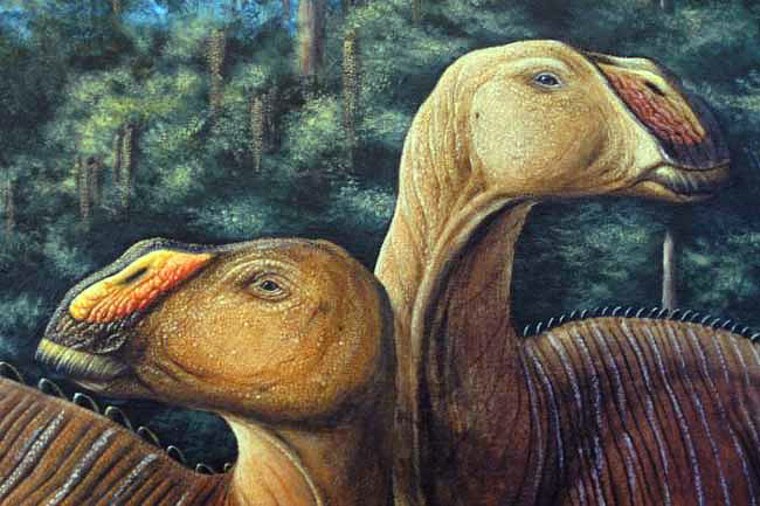A toothy, big-boned dinosaur uncovered in Utah is helping scientists recreate what ancient North America looked like 75 million years ago.
Dubbed Gryposaurus monumentensis, the new species was a member of the so-called duckbilled dinosaurs, so named because their flat, bony snouts resembled duck beaks. Unlike ducks, however, duckbilled dinosaurs, also called hadrosaurs, had teeth, which they used to munch on tough, fibrous plants.
Similar to a shark, a duckbilled dinosaur essentially had a conveyer belt of teeth in its mouth, a seemingly endless supply. G. monumentensis, for example, had more than 300 teeth available in its mouth to slice up plants. And stacked below in columns hidden within the jawbone were many more replacement teeth, so a duckbill might have sported more than 800 teeth at any moment.
"It was capable of eating most any plant it wanted to," said Terry Gates, a paleontologist at the Utah Museum of Natural History and the University of Utah who was involved in the discovery. "With its robust jaws, no plant stood a chance."
Jaws weren't the only robust thing about G. monumentensis. All of its bones were likewise massive. Scott Sampson, another Utah Museum paleontologist who was involved in the study, called the animal the "Arnold Schwarzenegger of duckbilled dinosaurs."
"It was a like a dinosaur on steroids," Sampson added. "The bones were thick, not just in the skull, but in the limbs as well."
The researchers think G. monumentensis was a key player in the ecosystem of ancient North America. "Duckbilled dinosaurs are the most common fossil that we find in the rock that we do our prospecting," Gates said. "From that we know they were probably one of the most common dinosaurs within this ecology 75 million years ago."
The new species is detailed in the Oct. 3 issue of the Zoological Journal of the Linnean Society.
Big problem
Most of what is known about G. monumentensis comes from a massive well-preserved skull and jawbone unearthed by the researchers in the Kaiparowits Formation in Utah in 2003. The team later found enough bones in other areas of the site to assemble a nearly complete skeleton. From these bones, paleontologists estimate the creature's head would have been just under three feet (one meter) in length, with an adult G. monumentensismeasuring up to 30 feet (9 meters) in length.
The heftiness of G. monumentensis poses several problems for paleontologists trying to envision what North America looked like 75 million years ago. How the massive duckbill could survive alongside other giants, and why it didn't mingle even with its own relatives, are two head-scratchers.
At that time, southern Utah was very different from the arid desert and red-rock country there today. During much of the Late Cretaceous, a shallow sea split North America into eastern and western landmasses.
The western landmass, where G. monumentensislived, was only about one-fifth the size of North America. Yet crammed on this relatively small island were several large plant-eating dinosaur species.
While G. monumentensis chomped greens in Utah, other species of duckbilled dinosaurs were grazing farther north in places such as Montana and Alberta, Canada.
Dinosaur overcrowding
Sampson estimates that as many as six duckbilled dinosaur species lived in so-called "West America" at any one time, up to 30 different duckbilled species over a span of several million years. And all of this was in addition to other large plant-eating dinosaurs, such as horned reptiles that were the ancestors of Triceratops.
Why the multiple duckbilled species didn't intermingle more is a mystery, since scientists know of no physical barriers like rivers or mountains that would have impeded the creatures' movements. "Think about white-tailed deer that are found all over North America today," Sampson said. "We wouldn't expect to see that many kinds of species and separated on such a fine resolution."
A related mystery is how such a relatively small landmass could support so many massive plant-eaters. One idea is that duckbills and other large plant-eaters had slower metabolisms, allowing them to subsist on much less food, yet still grow to their gargantuan sizes. Or there might have been an unusual overabundance of plants for dinosaurs to graze on. Yet another idea is that the climate of West America varied across latitudes, and that this "climate gradient" prevented dinosaurs from mixing.
If "the climates were somewhat different, then the plants would have been different," Sampson said. "If the plants were different, then the plant-eating animals are going to be different."
